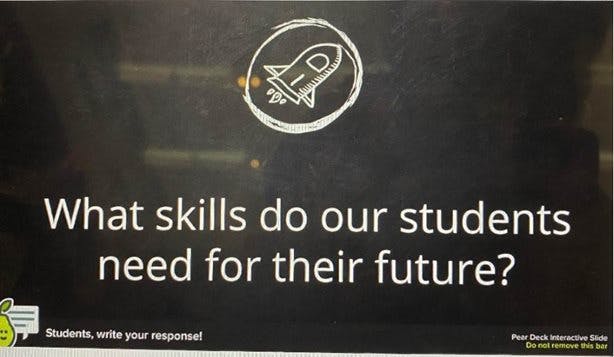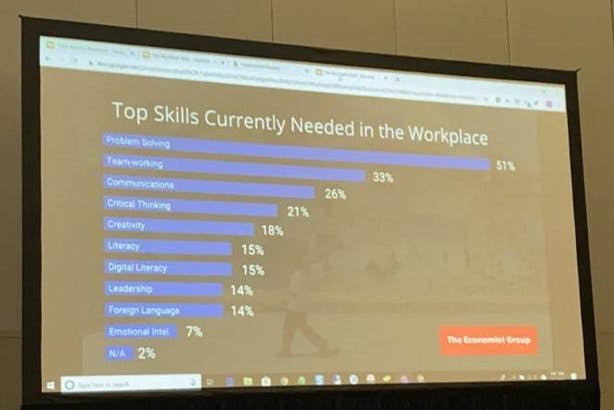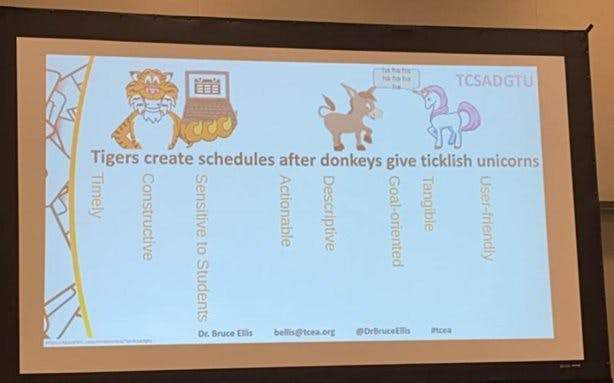TCEA Recap: Change the Process to Support the Purpose
Last week, a group of Texthelpers attended TCEA, the Texas Computer Education Association conference. Compared to previous years, there was a noticeable increase in discussions around feedback/assessments and the need for change. But before changing, we first need to recognize what to change.
In Eric Curts’ TCEA session, ‘The Big Blank Wall’, he spoke about the difference between process and purpose, and why it’s important for educators to distinguish between the two. Process is what we do, and purpose is why we do it. For example, if our purpose is to give feedback on a student’s piece of writing, our process could be using a red pen to mark errors.
However, when we confuse process and purpose, we open ourselves up to failure. Once you become familiar with a process that you believe is working for you and your students, it’s hard to give it up - and even harder to separate it from the larger purpose. But, if you can differentiate your process from the purpose, you’ll be more likely to see alternatives to that process that may work better for you and your students.
This is particularly true as more and more technology is integrated into the classroom, and as teachers are increasingly expected to help their students become ‘Future Ready’.
So, let’s go back to our original example of giving feedback by marking up a student paper with a red pen. If we separate the feedback from the red pen, we can start to consider other ways - and often more meaningful ways - to deliver feedback to students (while preparing them for the future).
In Catlin Tucker’s session, ‘Move Feedback & Assessment into the Classroom with Blended Learning Models’, she suggested making students more responsible for the assessment process. One of her recommendations was to rethink our current processes and consider a student-led workflow, which could go something like this:
- Student finishes their written assignment
- Student uses technology like Read&Write’s text-to-speech or Check It to correct the spelling, grammar, and flow of their paper
- Teacher provides a model paper and rubric so students can self-assess the quality of their work
- Student reflects on their writing and progress in a learning log
I know what you may be thinking. Students doing their own assessments?! That’s crazy! And yes, at first glance, this process does seem crazy - because it’s new. But, if we focus on the purpose and not the process, you can see that they are still getting feedback, just in a different way.
And, in fact, they are getting that feedback in a way that better prepares them for the Future of Work. As Eric Curts shared, three of the top skills currently needed in the workplace are problem solving, communication, and critical thinking. Encouraging students to tackle their own assessments requires them to solve problems, communicate their learning, and think critically about their work, rather than just waiting for the teacher to tell them what they did or didn’t accomplish.
This is just one example of how you can rethink the process to reach your feedback purpose. In another Eric Curts session, ‘Feedback Tools for Google Docs’, he shared how “we can give better feedback, really rich feedback to our students with technology”.
From Read&Write’s voice notes to video recordings with Screencastify, Eric highlighted a variety of tools that can bring new life to the feedback process. And despite their differences, these tools all have several key attributes in common: they help educators provide timely, descriptive, goal-oriented, actionable, constructive, sensitive, user-friendly, and tangible feedback to students. And for Bruce Ellis, the Director of Professional Development at TCEA, those traits are what make up effective feedback. He even created a mnemonic to help you remember!
At the Texthelp booth, we were showcasing our writing assessment and achievement tool, WriQ, to TCEA attendees. The new WriQ student experience tracks writing burst length, which is a measure of writing fluency - the longer the burst, the higher the fluency. By enabling students to track their own bursts, we are giving them feedback that meets the criteria above:
- Timely: students can track their writing bursts in real-time, as they write
- Constructive & Sensitive to Students: writing bursts are a meaningful way to deliver feedback on writing fluency that is positive and motivational
- Actionable: students can improve their writing fluency by practicing writing longer bursts
- Goal-Oriented: in future updates, WriQ will have achievement badges for students to work towards
- Tangible: the WriQMeter, which tracks writing bursts, is a physical representation of the student’s writing progress
- User-Friendly: the WriQMeter is simple and unobtrusive for ease-of-use for the student
To learn more about the new student experience, check out our introductory video:
What do you think about changing your feedback and assessment process? Do you want to try any of the above examples with your students? Any other ideas to revamp the feedback process? Share your thoughts in the comments below!




